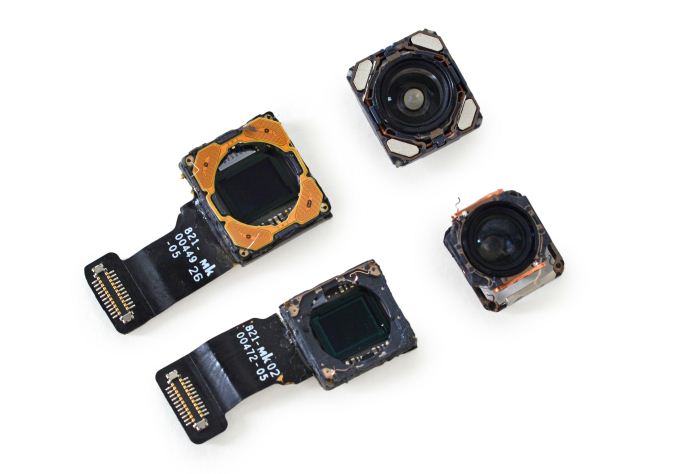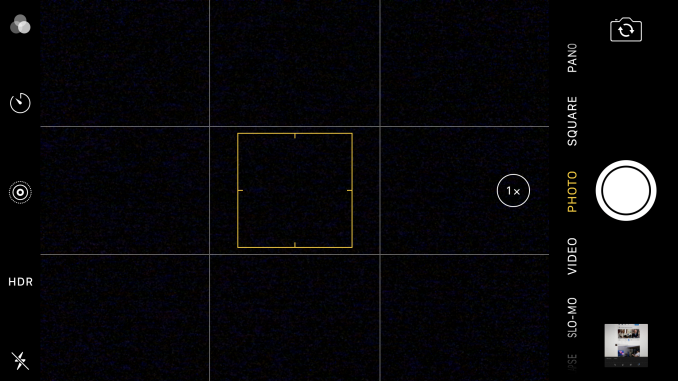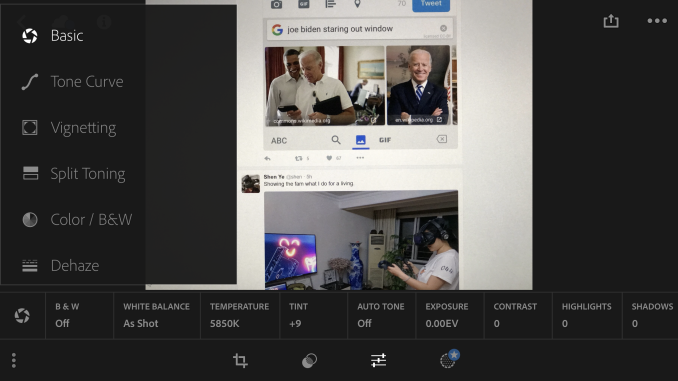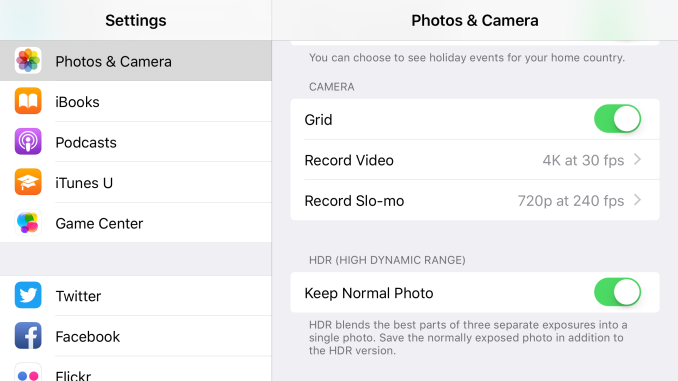The iPhone 7 and iPhone 7 Plus Review: Iterating on a Flagship
by Joshua Ho & Brandon Chester on October 10, 2016 8:00 AM EST- Posted in
- Smartphones
- Apple
- Mobile
- iOS
- iOS 10
- iPhone 7
- iPhone 7 Plus
Camera Architecture
Before we get into the results of the camera output it's always helpful to actually examine the basic characteristics and hardware that make up the camera as a number of characteristics can be predicted or understood by looking at the basic hardware. The CIS technology used can have significant impacts on noise, active area, and a number of other features including slow motion video capture. However, to say that the CIS is the only area worth examination ignores the whole chain of hardware and software needed to make a great camera. With that said we can start our look at the camera with the table below which summarizes a number of high level details for the camera.
| Apple iPhone Cameras | ||||
| Apple iPhone 6s Apple iPhone 6s Plus |
Apple iPhone 7 Apple iPhone 7 Plus |
|||
| Front Camera | 5.0MP | 7MP | ||
| Front Camera - Sensor | Sony ? (1.12 µm, 1/5") |
Sony Exmor RS (1.0 µm, 1/?") |
||
| Front Camera - Focal Length | 2.65mm (31mm eff) | 2.87mm (32mm eff) | ||
| Front Camera - Max Aperture | F/2.2 | F/2.2 | ||
| Rear Camera | 12MP | 12MP | ||
| Rear Camera - Sensor | Sony Exmor RS (1.22 µm, 1/3") |
Sony Exmor RS (1.22 µm, 1/3") |
||
| Rear Camera - Focal Length | 4.15mm (29mm eff) | 4mm (28mm eff) 8mm (56mm eff) Secondary |
||
| Rear Camera - Max Aperture | F/2.2 | F/1.8 F/2.8 Secondary |
||
Looking at the camera of the iPhone 7 in some ways the cadence has changed up a bit. While the iPhone 5s to iPhone 6 transition saw the use of almost identical camera sensor and optics, the iPhone 7 actually changes things up relative to the camera that we saw in the iPhone 6s, likely because the difference between the iPhone 6 and 6s camera was fairly mild in still photos. The iPhone 7 still appears to use a similar sensor on the rear, but with a new set of optics that incorporates a wider aperture. Apple seems to be fighting against serious z-height limitations, so we’re continuing to see a reduction in focal length as the iPhone 7 is now basically comparable to phones like the One M7 with its 28mm equivalent focal length. It’d be interesting to know transmission efficiency which would allow for proper comparisons between generations but considering how most dSLR lenses don't' list these specs it's not a surprise that we don't see this kind of disclosure.

iPhone 7 Plus's dual camera modules (Image Courtesy iFixit)
What isn’t listed on the spec sheet is that the iPhone 7 now has OIS, which is going to be a serious step up in terms of performance for anyone upgrading from the iPhone 6 or 6s. While Apple has some proprietary EIS that allows for really impressive performance despite the lack of OIS, a physical mechanism to compensate for hand shake is going to make for a more effective system in the first place, as it fixes the problem before the photons are captured. Apple continues to use advanced software to enable long exposure without visible blur or hand shake so the addition of OIS shouldn’t have any noticeable drawbacks other than increased shot latency in low light.
Of course, the iPhone 6s Plus already had OIS, so for the iPhone 7 Plus there is a new secondary camera with a focal length that is twice as long as the primary camera. However, the aperture is smaller, which means that in low light the system is going to automatically fall back to the primary camera which is still better in low light as far as I can tell, especially because the second camera lacks OIS. However, in bright daytime conditions the second camera’s longer focal length allows for better portraits and better detail in general. This helps to compensate for the iPhone’s sensor size and z-height limitations, but can only really help in daytime conditions.
Interestingly enough, Apple is actually one of the first OEMs to my knowledge to adopt a 1 micron pixel pitch for a camera sensor, but this is being done for the front-facing camera. I’m kind of curious to know what led to this decision as the optics are probably not going to be able to resolve such a small pixel size. We generally don’t review front-facing cameras but for the people that care about this sort of thing I suspect that the FFC is mostly a sidegrade in the sense that it’s probably going to be used to enable higher resolution video capture rather than higher quality still photos.
Camera UX
As far as the camera application goes, there’s really nothing new this generation. If you’ve taken pictures with a relatively new iPhone, you’re going to be right at home with the iPhone 7’s camera UI. For those that haven’t used a relatively new iPhone before we can do a quick review to discuss what is and isn’t present. At a high level, the UI is split up into a few logical sections, with mode-specific options in their own section. Modal selection is on the opposite side, with text that fairly clearly delineates the purpose of each mode. Below the modal selection, general options are presented for things like changing between front and rear cameras as well as the shutter button and camera roll.
It's hard to really say much about the iPhone camera UI at this point because it’s been polished to the point that there’s really no obvious criticisms to make about it. Apple may have made the mistake of shipping a 16:9 preview for a 4:3 camera before, but it’s been years since glaring issues like that have come up. Tapping to focus allows for either locking focus and exposure or biasing the exposure, which is going to provide coverage for 95% of still image cases. Of course, if you want more fine adjustment the default camera app is going to be inadequate, but there are plenty of good manual camera applications on the market like ProCam, ProShot, and Manual Camera.
It’s worth mentioning that while Apple was far from first to implement RAW capture on smartphones, their implementation is differentiated by a real end to end solution. Something like the HTC 10 really needs Lightroom to bring out the best in its RAW captures, although Snapseed is still reasonably useful in a pinch. Apple is leveraging their ecosystem which allows for things like fully featured Adobe Lightroom for RAW processing. I thought for a very long time that processing RAW was infeasible in the context of a smartphone TDP without fixed-function hardware, so it’s incredibly impressive to see Lightroom working smoothly when processing RAW images.
While most of the camera UX is designed well, one noticeable issue here is that the camera settings are integrated into the settings application rather than the camera application itself. If you’re used to how iOS works this makes sense, but things like resolution settings for video are placed in this menu rather than integrated into the camera application which makes switching between these settings relatively painful if you’re used to something like the HTC 10’s camera UI which places resolution settings in a slide-out drawer. This isn't a huge issue but it's definitely something I noticed due to the need to rapidly switch between resolution settings for video testing. Your mileage may vary here if you don't particularly care for such issues. Overall though, the camera UX has few friction points.













377 Comments
View All Comments
grayson_carr - Monday, October 10, 2016 - link
You can still use your old headphones with the adapter included in the box.The Pixel has a better camera? I didn't realize reviews were already out.
Mediocre battery life? Did you even read the review? the only noteworthy phone that beats the iPhone 7 is the S7 Edge, and it beats it by what, 20 minutes?
The iPhones will charge a lot faster if you buy an iPad charger. Sucks that they don't include a higher W charger in the box, but you at least have an option for faster charging.
Good to know the screen with the most accurate colors of any phone ever, and the only one to include proper color management, and one of brightest screens of all time is passable!
So it's not worth $650-750 for you. Ok. That's fine. It seems to be worth that much to a whole bunch of other people though.
SquarePeg - Monday, October 10, 2016 - link
https://www.dxomark.com/Mobiles/Pixel-smartphone-c...grayson_carr - Tuesday, October 11, 2016 - link
Well if they said it, it must be true. After some of the scores they have given certain Sony phones, I will never trust them.jlabelle2 - Thursday, October 13, 2016 - link
"After some of the scores they have given certain Sony phones, I will never trust them."Here we are again... And earth is flat, I know...
mef - Monday, October 10, 2016 - link
"The screen is just passable": really???http://www.displaymate.com/iPhone7_ShootOut_1.htm
The iPhone 7 matches or breaks new Smartphone display performance records for:
• The Highest Absolute Color Accuracy for any display (1.1 JNCD) – Visually Indistinguishable from Perfect
• The Highest Absolute Luminance Accuracy for any display (±2%) – Visually Indistinguishable from Perfect
• Very Accurate Image Contrast and Intensity Scale (with Gamma 2.21) – Visually Indistinguishable from Perfect
• The Highest Peak Brightness Smartphone for any Average Picture Level APL (602 to 705 nits)
• The Highest (True) Contrast Ratio for any IPS LCD display (1,762) – Higher Dynamic Contrast Ratios are phony
• The Lowest Screen Reflectance for any Smartphone display (4.4 percent)
• The Highest Contrast Rating in High Ambient Light for a Smartphone for any APL (137 to 160)
• The Smallest Color variation with Viewing Angle (2.1 JNCD or less)
Toss3 - Tuesday, October 11, 2016 - link
They compared it to the iPhone 6, and while it is accurate, many people would still pick an AMOLED screen over the LCD any day of the week; samsung's recent amoled-screens are almost as accurate (negligible difference really, with infinite contrast and higher perceived sharpness both due to an increase in contrast and pixel density).R. Hunt - Thursday, October 13, 2016 - link
OLED will only be accepted by mainstream media as vastly superior the moment Apple starts using it.We all know this.
techconc - Thursday, October 13, 2016 - link
No, DisplayMate's review was not simply comparing the screen to the iPhone 6. There are areas where the iPhone 7 screen is best in class overall. Moreover, in a recent Wired article Dr. Soneira went on to say that the best screen overall is a "toss up" between the Galaxy's OLED and the iPhone 7's LCD. Both have inherent strengths and weaknesses. Neither is better overall.https://www.wired.com/2016/09/iphone-7s-screen-loo...
Constructor - Monday, October 17, 2016 - link
No, they're not, since Android has no color management whatsoever. Plus AMOLED deteriorates over time, including pixel-wise burn-in and incremental color degradation (also varying across the display area).Samsung et al clearly don't care much about as you can see from their short support span for these devices, but Apple devices are often used for many years and they stay very high quality for years; They also get full update and upgrade support directly from Apple for 5 years.
AMOLED is simply not good enough and not durable enough for that, even if you did calibrate it in the factory and if you had an OS with color management.
TechnologyGuy - Monday, October 10, 2016 - link
I specifically made no mention of the OS because that is subjective. I have owned both Android and iOS phones and I have always preferred Android over iOS. I do understand people might prefer one over the other but I like to micro-manage and customization of every little detail is important to me.Yes, Pixel camera reviews are out - please search for yourself. Plugging in an adapter/dongle is not what I want to bother to do every time I use the phone. An extra accessory to lose, a feature that adds zero (negative) value for me. Battery life in real world usage is not quite the same as on the test - two of my colleagues have already acquired the phone with poorer battery life than the 6S. In addition, other sites' battery tests do show mediocre results for the iPhone 7.
I am aware of the color accuracy, which is why I said passable. Simply put, a so-so black level and a resolution below quad HD is not acceptable for my use. And yes, I can tell the difference on a 5 inch phone.